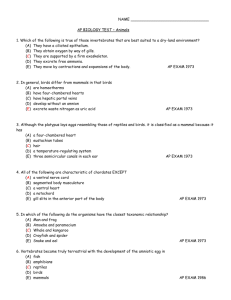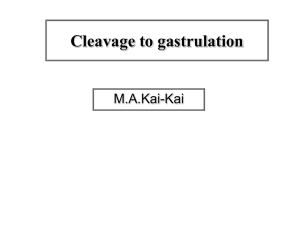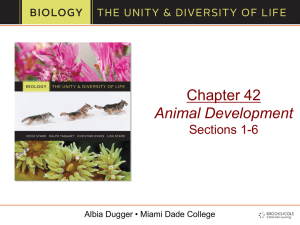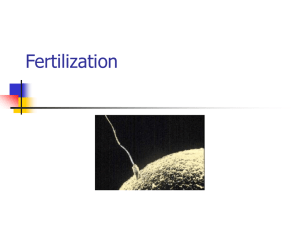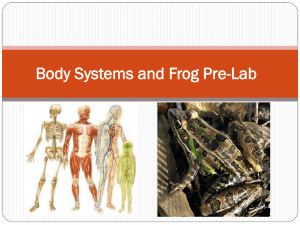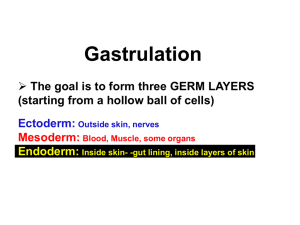chapter38_Sections 9
advertisement
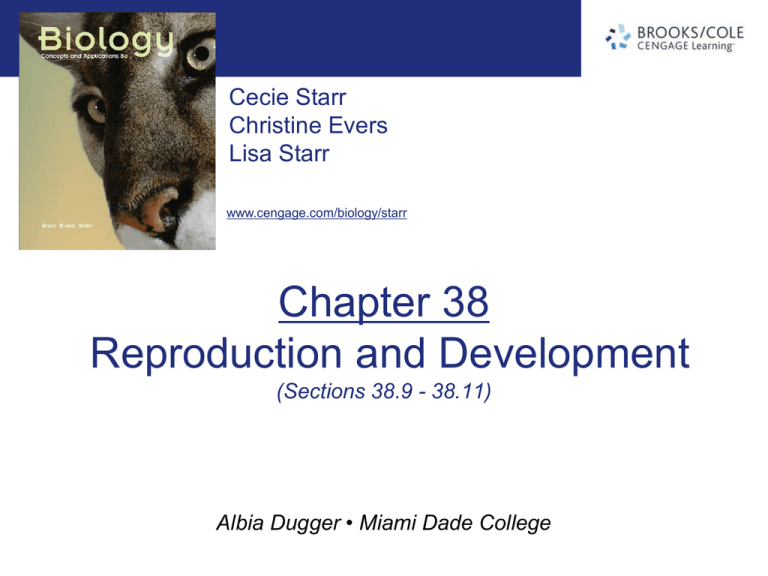
Cecie Starr Christine Evers Lisa Starr www.cengage.com/biology/starr Chapter 38 Reproduction and Development (Sections 38.9 - 38.11) Albia Dugger • Miami Dade College 38.9 Overview of Animal Development • All sexually reproducing animals begin life as a zygote, the diploid cell that forms at fertilization • The same development steps and processes occur in all vertebrates – evidence of their common ancestry 5 Stages of Vertebrate Development • Fertilization • Sperm penetrates an egg, the egg and sperm nuclei fuse, and a zygote forms • Cleavage • Mitotic cell divisions yield a ball of cells (blastula); each cell gets a different bit of the egg cytoplasm • Gastrulation • Cell rearrangements and migrations form a gastrula, an early embryo that has primary tissue layers 5 Stages of Vertebrate Development • Organ formation • Organs form as the result of tissue interactions that cause cells to move, change shape, and commit suicide • Growth and tissue specialization • Organs grow in size, take on mature form, and gradually assume specialized functions Overview: Frog Development transformation to adult nearly complete adult, three years old Sexual reproduction (gamete formation, external fertilization) tadpole larva (tadpole) organ formation cleavage eggs and sperm zygote Fig. 38.13, p. 642 Overview: Frog Development transformation to adult nearly complete adult, three years old Sexual reproduction (gamete formation, external fertilization) tadpole larva (tadpole) organ formation eggs and sperm cleavage zygote Stepped Art Fig. 38.13, p. 642 Details of Frog Development (1) • Cleavage divides a zygote’s cytoplasm into smaller blastomeres • Number of cells increases, but the zygote’s original volume remains unchanged • cleavage • Mitotic division of an animal cell Details of Frog Development (1) Details of Frog Development (1) gray crescent Here we show the first three divisions of cleavage, a process that carves up a zygote’s cytoplasm. In this species, cleavage results in a blastula, a ball of cells with a fluid-filled cavity. 1 Fig. 38.13.1, p. 643 Details of Frog Development (2) • In this species, cleavage results in a blastula, a ball of cells with a fluid-filled cavity (blastocoel) • Tight junctions hold cells of the blastula together • blastula • Hollow ball of cells that forms as a result of cleavage Details of Frog Development (2) Details of Frog Development (2) blastocoel blastula Cleavage is over when the blastula forms. 2 Fig. 38.13.2, p. 643 Details of Frog Development (3) • The blastula becomes a three-layered gastrula by the process of gastrulation: Cells at the dorsal lip migrate inward and start rearranging themselves • gastrula • Three-layered developmental stage formed by gastrulation • gastrulation • Cell movements that produce a three-layered gastrula Germ Layers • A gastrula consists of three primary tissue layers (germ layers) • Three germ layers give rise to the same types of tissues and organs in all vertebrates – evidence of a shared ancestry • germ layer • One of three primary layers in an early embryo Three Embryonic Germ Layers • ectoderm • Outermost tissue layer of an animal embryo • endoderm • Innermost tissue layer of an animal embryo • mesoderm • Middle tissue layer of a three-layered animal embryo Details of Frog Development (3) Details of Frog Development (3) ectoderm dorsal lip future gut cavity yolk plug neural plate ectoderm mesoderm endoderm The blastula becomes a three-layered gastrula—a process called gastrulation. At the dorsal lip (a fold of ectoderm above the first opening that appears in the blastula) cells migrate inward and start rearranging themselves. 3 Fig. 38.13.3, p. 643 Details of Frog Development (4) • Organs begin to form as a primitive gut cavity opens up • A neural tube, then a notochord and other organs, form from the primary tissue layers • Many organs incorporate tissues derived from more than one germ layer Details of Frog Development (4) Details of Frog Development (4) neural tube notochord gut cavity Organs begin to form as a primitive gut cavity opens up. A neural tube, then a notochord and other organs, form from the primary tissue layers. 4 Fig. 38.13.4, p. 643 Details of Frog Development (5) • In frogs, and some other animals, a larva undergoes metamorphosis: a remodeling of tissues into an adult form • The tadpole is a swimming larva with segmented muscles and notochord extending into a tail • During metamorphosis, the frog grows limbs, and the tadpole tail is absorbed Details of Frog Development (5) Tadpole Metamorphosis Sexually mature, fourlegged adult frog ANIMATION: Leopard frog life cycle To play movie you must be in Slide Show Mode PC Users: Please wait for content to load, then click to play Mac Users: CLICK HERE 38.10 Early Marching Orders • Egg cytoplasm includes yolk proteins, mRNA transcripts, tRNAs and ribosomes, and other proteins • Some cytoplasmic components are not distributed evenly, but localized in one particular region or another • cytoplasmic localization • Accumulation of different materials in different regions of the egg cytoplasm Cytoplasmic Localization • In a yolk-rich egg, the vegetal pole has most of the yolk and the animal pole has little • In some amphibian eggs, pigment molecules accumulate in the cell cortex, close to the animal pole • After fertilization, a gray crescent forms, where substances essential to development are localized Experiment: Cytoplasmic Localization • At fertilization, cytoplasm shifts, and exposes a gray crescent opposite the sperm’s entry point • First cleavage normally distributes half of the gray crescent to each descendant cell Experiment: Cytoplasmic Localization animal pole pigmented cortex yolk-rich cytoplasm vegetal pole sperm penetrating egg gray crescent fertilized egg A Many amphibian eggs have a dark pigment concentrated in cytoplasm near the animal pole. At fertilization, the cytoplasm shifts, and exposes a gray crescent-shaped region just opposite the sperm’s entry point. The first cleavage normally distributes half of the gray crescent to each descendant cell. Fig. 38.14a, p. 644 ANIMATION: Cytoplasmic localization To play movie you must be in Slide Show Mode PC Users: Please wait for content to load, then click to play Mac Users: CLICK HERE Experiment: Cytoplasmic Localization • In one experiment, the first two cells formed by normal cleavage were physically separated from each other • Each cell developed into a normal larva Experiment: Cytoplasmic Localization gray crescent of salamander zygote First cleavage plane; gray crescent split equally. The blastomeres are separated experimentally. Two normal larvae develop from the two blastomeres. B In one experiment, the first two cells formed by normal cleavage were physically separated from each other. Each cell developed into a normal larva. Fig. 38.14b, p. 644 Experiment: Cytoplasmic Localization • In another experiment, one descendant cell received all the gray crescent, and developed normally • The other gave rise to an undifferentiated ball of cells Experiment: Cytoplasmic Localization gray crescent of salamander zygote First cleavage plane; gray crescent missed entirely. The blastomeres are separated experimentally. A ball of Only one undifferentiated normal larva cells forms. develops. C In another experiment, a zygote was manipulated so one descendant cell received all the gray crescent. This cell developed normally. The other gave rise to an undifferentiated ball of cells. Fig. 38.14c, p. 644 Cleavage: The Start of Multicellularity • During cleavage, a furrow appears on the cell surface and defines the plane of the cut • The plane of division is not random – it dictates what types and proportions of materials a blastomere will get • Each species has a characteristic cleavage pattern From Blastula to Gastrula • At gastrulation, certain cells at the embryo’s surface move inward through an opening on the surface • Cells in the dorsal (upper) lip of the opening are descended from a zygote’s gray crescent • Gastrulation is caused by signals from dorsal lip cells Gastrulation in a Fruit Fly • The opening cells move in through will become the fly’s mouth; descendants of stained cells will form mesoderm Gastrulation in a Fruit Fly Fig. 38.15a, p. 645 Gastrulation in a Fruit Fly Fig. 38.15b, p. 645 Gastrulation in a Fruit Fly Fig. 38.15c, p. 645 Gastrulation in a Fruit Fly Fig. 38.15d, p. 645 Experiment: Dorsal Lip Transplant • Dorsal lip of a salamander embryo was transplanted to a different site in another embryo – a second set of body parts started to form Experiment: Dorsal Lip Transplant A Dorsal lip excised from donor embryo, grafted to novel site in another embryo. Fig. 38.16a, p. 645 Experiment: Dorsal Lip Transplant B Graft induces a second site of inward migration. Fig. 38.16b, p. 645 Dorsal Lip Transplant (cont.) • The embryo develops into a “double” larva, with two heads, two tails, and two bodies joined at the belly Dorsal Lip Transplant (cont.) C The embryo develops into a “double” larva, with two heads, two tails, and two bodies joined at the belly. Fig. 38.16c, p. 645 ANIMATION: Embryonic induction To play movie you must be in Slide Show Mode PC Users: Please wait for content to load, then click to play Mac Users: CLICK HERE Specialized Cells, Tissues, and Organs • All cells in an embryo have the same genes • Selective gene expression causes different cell lineages in the embryo to express different subsets of genes • Selective gene expression is the key to cell differentiation – the process by which cell lineages become specialized in composition, structure, and function Cell Differentiation • An adult human has about 200 differentiated cell types • Example: Cells of one lineage turn on genes for crystallin, a transparent protein that forms the lens of the eye – no other cells in the body make crystallin • A differentiated cell still retains the entire genome • It is possible to clone an adult animal (a genetic copy) from one of its differentiated cells Cell Communication in Development • Long-range intercellular signals (morphogens) diffuse out from certain embryonic cells and form a concentration gradient in the embryo that controls differentiation • morphogen • Chemical encoded by a master gene; diffuses out from its source and affects development • Effects on target cells depend on its concentration Cell Communication in Development • Other chemical signals only operate at close range • Example: Cells of a salamander gastrula’s dorsal lip cause adjacent cells to migrate inward and become mesoderm • embryonic induction • Embryonic cells produce signals that alter the behavior of neighboring cells Cell Movements and Apoptosis • Long-range and short-range signals regulate development of tissues and organs • Organs begin to form as cells migrate, entire sheets of tissue fold and bend, and specific cells die on cue Cell Movements in the Brain • Neurons form in the center of the brain, then creep along extensions of glial cells or axons of other neurons until they reach their final position • Once in place, they send out axons Cell Movements in the Brain A Cells migrate. This graphic shows one embryonic neuron (orange) at successive times as it migrates along a glial cell (yellow). Its adhesion proteins stick to glial cell proteins. Fig. 38.17a, p. 646 Neural Tube Formation • Sheets of cells expand and fold to form the neural tube 1. Gastrulation produces a sheet of ectodermal cells 2. Cells at the embryo’s midline elongate and neighboring cells become wedge-shaped, forming a neural groove 3. Edges of the groove move inward, and flaps of tissue fold and meet at the midline, forming the neural tube • The neural tube later develops into the brain and spinal cord Neural Tube Formation Neural Tube Formation Gastrulation produces a sheet of ectodermal cells. 1 A neural groove forms as microtubules constrict or lengthen in different cells, making the cells change shape. 2 Edges of the groove meet and detach from the main sheet, forming the neural tube. neural groove 3 neural tube B Cells change shape. Here, shape changes in ectodermal cells form a neural tube. Fig. 38.17b, p. 646 Apoptosis • Signals from certain cells activate self-destruction in target cells (apoptosis), which helps sculpt body parts • Apoptosis causes a tadpole to lose its tail and it separates the digits of the developing human hand • apoptosis • Mechanism of cell suicide Apoptosis • As a human hand develops, cells in the webs of skin between digits die ANIMATION: Formation of human fingers To play movie you must be in Slide Show Mode PC Users: Please wait for content to load, then click to play Mac Users: CLICK HERE Pattern Formation • Pattern formation is the process by which certain body parts form in a specific place • Example: Signals from AER (apical ectodermal ridge) at the tips of limb buds induce mesoderm beneath it to form a limb • pattern formation • Formation of body parts in specific locations Experiment: AER and Limb Formation • AER of a limb bud tells mesoderm under it to form a limb • If AER from a chick’s wing bud is removed, wing development stops • Earlier positional cues determined what the mesoderm will become – mesoderm from a chick’s hindlimb implanted under wing AER forms a leg Experiment: AER and Limb Formation Experiment: AER and Limb Formation mesoderm of chick embryo forelimb AER (region of signalsending ectoderm) A Experiment 1: Remove wing bud’s AER AER removed B Experiment 2: Graft a bit of leg mesoderm under the AER of a wing mesoderm wing from leg no limb forms leg forms Fig. 38.18, p. 647 Experiment: AER and Limb Formation mesoderm of chick embryo forelimb AER (region of signalsending ectoderm) A Experiment 1: Remove wing bud’s AER AER removed B Experiment 2: Graft a bit of leg mesoderm under the AER of a wing mesoderm wing from leg no limb forms leg forms Stepped Art Fig. 38.18, p. 647 Evolution and Development • Where and when particular genes are expressed determines how an animal body develops: • Localized molecules in an unfertilized egg induce expression of master genes in the zygote • Products of master genes form gradients in the embryo • Depending on where they fall within these gradients, cells activate or suppress other genes Evolution and Development (cont.) • Positional information set up by concentration gradients of products of master genes affects expression of homeotic genes, which regulate development of specific body parts • All animals have similar homeotic genes • homeotic gene • Type of master gene; its expression controls formation of specific body parts during development Evolution and Development (cont.) • Evolution of body plans are influenced by physical constraints (such as surface-to-volume ratio) and existing body framework (such as four limbs) • Interactions among master genes also restrain evolution, since a major change in any one probably would be lethal • Mutations led to a variety of forms among animal lineages by modifying existing developmental pathways, rather than entirely new genetic innovations Key Concepts • Principles of Development • The same processes regulate development of all animals • Division of the single-celled zygote distributes different materials to different cells • These cells go on to express different master genes that regulate formation of body parts in particular places ANIMATION: Early frog development To play movie you must be in Slide Show Mode PC Users: Please wait for content to load, then click to play Mac Users: CLICK HERE
